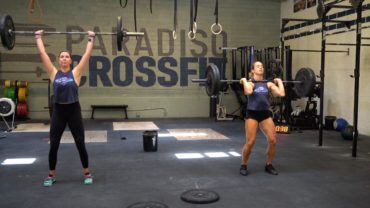Stay Hydrated My Friends
EIE CHALLENGE WEEK 5: Our goal for this week is to focus on hydration. The general recommendation is to consume half of your bodyweight in ounces of water per day (or higher with a higher activity level). This means if you weigh 150lbs, you should try to drink 75 ounces of water. Hydration is an often overlooked and very important factor in achieving your health and fitness goals. So take a look at how much you are consuming per day, adjust accordingly and see how you feel!
Weekly Programming Links: Group Class, Venice Barbell Club, Track Night
Monday, February 17, 2014
Prehab
15 Dislocates
Keg Drill, 2 minutes
Groiners/Gristle
Banded Hip Extension, 1 minute per side
Warmup
10 Behind the Neck Snatch Grip Press
10 Overhead Lunges in Snatch Grip
10 Good Mornings
10 Overhead Squats
5 High Hang Power Snatch
5 Hang Power Snatch
5 High Hang Snatch
5 Hang Snatch
Notes: Use a PVC pipe or barbell.
Classic Strength
12 min to work up to heavy 3 rep Hang Snatch
Notes: Hang position is just above the knee. May be a full squat or power snatch. Prioritize hip contact and full lockout.
Advanced Strength
12 min to work to a max 3-Position Snatch (1. Hi-Hang – shoulders even with or slightly behind bar, bar in contact with pelvis. 2. Hang – just above knee. 3. Low-Hang – 2? from the floor)
Notes: Focus on getting full extension first then getting under the bar quickly. Should be a full squat after each rep.
Conditioning
15 minute AMRAP of:
10 Wall Balls 20/14#
10 Burpees jumping on to 45/25lb weight
10 C2B Pullups
20 Wall Balls
10 Burpees
10 C2B Pullups
30 Wall Balls
10 Burpees
10 C2B Pullups
40 Wall Balls…
*Add 10 Wall Balls after every completed round.
Notes: The burpees will be performed by jumping onto a 45/25lb plate, extending the hips at the top then returning to start position. If you are not proficient with C2B pull ups, you may substitute with regular pull ups.
Cool Down
Foam Roll Quads, 1 min each
Sampson Stretch, 30 sec each
Pigeon Stretch, 1 min each
Lat Stretch, 30 sec each
Baylie on the high rings
This week we are challenging you to be consistent with your hydration! Your daily intake of water can easily be calculated by dividing your body weight by two, and drinking that amount in ounces. For example, a 150lb individual would consume 75 ounces (2.2 Liters or 9.3 glasses) of water per day. This amount would increase with exercise, higher sweat rates, and warmer weather. It’s a great baseline to start with, and probably more water than you are currently drinking right now. Tea and coffee are allowed but do not contribute to your daily water intake. Soda, juice, and alcohol should be avoided and do not contribute either.
Here are some random facts about water and your body:
Water is vital for all forms of life, and makes up roughly 60% of your body weight. Your body composition determines the exact amount; for example, bone contains 22% water, fat cells contain 25%, muscle cells contain 75%, and blood contains 83%. Digital scales use this information to estimate your body fat percentage by sending an electrical current through your body and measuring the speed at which it travels, which will depend on your body composition and total water to conduct the current. Water weight is also affected by food intake. For every gram of stored carbohydrate, 3 to 4 grams of water ares stored with it. Higher carbohydrate diets can lead to more fluid storage, while lower carbohydrate diets can lead to decreased fluid storage. Higher intake of protein leads to increased fluid loss in urine due to protein metabolism. That is why people experience rapid water weight loss when they switch to a high protein, low carbohydrate diet like the Nutritional Guidelines we promote here at PCF!
Your body is constantly working to maintain fluid balance in the body. The two most common imbalances are dehydration (low water relative to electrolytes) and hyponatremia (high water relative to electrolytes). To fight off dehydration, your body releases hormones that increase water retention in the body and stimulate the thirst mechanism. This occurs at a 1-2% reduction of total body weight, but at this point athletic performance and mental clarity have already declined. You should have a plan to drink your water throughout the day and not wait for the thirst mechanism. During exercise, sweat loss leads to a reduction of in blood volume (remember blood is 83% water), the heart has to work harder to pump blood, and heart rate must go up to deliver the same cardiac output. Sweat also leads to electrolyte imbalances that should be replaced during and after exercises (see my past post How to lose ½ pound in 20 minutes for more information on electrolyte loss). In terms of mental clarity, symptoms of dehydration include headache, fatigue, low blood pressure, dizziness, fainting, nausea, rapid heart rate, and constipation. If that sounds a lot like a hangover to you, you’re right! High alcohol intake suppresses the hormones that control thirst and water regulation, thus we urinate more and are more easily dehydrated, leading to that “hangover” the next morning!
Everyone knows that drinking water is good for your health. We all know we should avoid alcohol, juices, and sodas and drink water instead. It has been shown to increase weight loss, increase mental focus, regulate bowel movements, increase athletic performance, increase flexibility, reduce joint pain, and even reduce the risk of cancer. Make the switch to half of your body weight in ounces and feel the difference!
Another PCF water related post: Stay Thirsty My Friends















